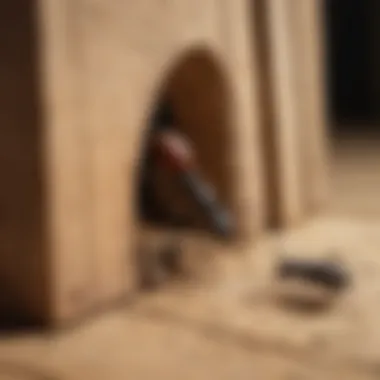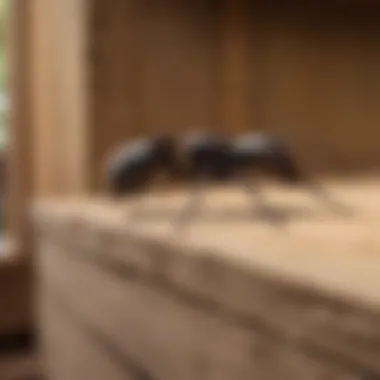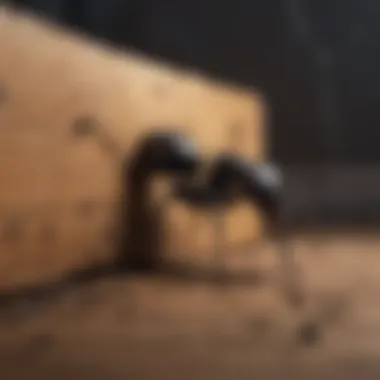Effective Strategies to Eliminate Carpenter Ants


Intro
Carpenter ants can create extensive damage if left unchecked. Unlike termites, carpenter ants do not eat wood, but they excavate it to create nests. This activity can lead to structural vulnerabilities in homes. Understanding how to deal with these pests is essential for homeowners who wish to maintain their properties.
This article will guide readers through recognizing carpenter ant infestations, understanding their biology, and employing effective elimination strategies. Homeowners will learn practical steps that can be integrated into their routines to safeguard living spaces against these intruders.
By arming oneself with knowledge and employing proactive prevention techniques, it is possible to protect a home from future carpenter ant threats. Thus, addressing the issue now can save considerable time and expense down the line.
Understanding Carpenter Ants
Understanding the biology, behavior, and lifecycle of carpenter ants is critical for homeowners. It empowers individuals with the knowledge they need to effectively manage and eliminate these pests. Carpenter ants are not only a nuisance but also threaten the structural integrity of homes. Knowing how they function and reproduce can inform your decision-making concerning prevention and elimination strategies.
Biology and Behavior
Carpenter ants, scientifically known as Camponotus, are large, robust insects characterized by their black or reddish-brown coloration. They typically range from 1/4 to 1/2 inch in length. Their size and structure allow them to forage efficiently and establish colonies that can be challenging to eradicate once they infest a home.
These ants are social creatures, living in communities that can consist of thousands of individuals. Within these colonies, there are various roles. The queen is responsible for reproduction, while workers take care of foraging, nest building, and caring for the young. Carpenter ants prefer to hollow out wood to create nests. Unlike termites, they do not eat wood, but they can weaken structures over time by tunneling through it.
Life Cycle Overview
The life cycle of carpenter ants is divided into four stages: egg, larva, pupa, and adult. Understanding these stages helps in identifying the time frames for potential infestations. The queen can lay hundreds of eggs, with the gestation period lasting about 4 to 6 weeks.
- Egg: Tiny and white, these are less than 1/16 inch long.
- Larva: Once the eggs hatch, larvae appear as white, grub-like forms and rely on worker ants for care and feeding.
- Pupa: After several weeks, larvae enter the pupal stage, resembling the adult ants.
- Adult: Following the pupal stage, mature ants emerge, ready to inhabit their new roles within the colony.
This cycle can lead to significant colony growth in a short time, which is why early identification is crucial.
Identifying Carpenter Ants
Identifying carpenter ants involves more than just spotting the insects themselves. Homeowners should look for several indicators of an infestation:
- Physical Appearance: Noting their large size and varying colors helps differentiate them from other ant species.
- Frass: This is the sawdust-like material found near nesting sites, resulting from the excavation of wood.
- Sound: Sometimes, faint rustling noises can be heard inside wooden structures, indicating movement of ants within.
- Sightings: Observing foraging ants inside and outside the home, especially at night when they are most active.
Recognizing these signs early can mitigate damage and simplify the elimination process.
Signs of Infestation
Understanding the signs of carpenter ant infestation is crucial for all homeowners. Early detection can make a significant difference in the eradication process. Recognizing the indicators can prevent minor issues from escalating into severe structural damage. Neglecting these signs often leads to increased repair costs and safety hazards. By being vigilant, homeowners can act promptly, thereby minimizing risks associated with carpenter ants.
Visual Indicators
Visual indicators are among the most apparent signs of a carpenter ant infestation. Homeowners may notice the presence of ant trails along walls, ceilings, and foundations. Carpenter ants range in size from 1/4 to 1/2 inches, making them easily identifiable when spotted.
Wood shavings near wooden structures can also signal an infestation. These shavings are often a result of ants tunneling through wood to create nesting sites. In addition, damaged wood may show irregular, smooth channels or galleries within, usually found in wooden beams or other structural components. If you come across these signs, take note:
- Trails of ants: Look for ants marching in a line, indicating their movement to and from a food source or nesting site.
- Wood shavings: Small piles of sawdust near wooden areas are troubling signs.
- Hollowed wood: Soft wood that can be easily punctured with a tool can mean carpenter ants are nesting inside.


Auditory Signs
While visual indicators are essential for spotting carpenter ants, auditory signs can also provide crucial information about an infestation. Homeowners may hear a faint rustling noise within walls, particularly in the evening or at night when the environment is quiet. This sound may come from the ants as they excavate and move through the wood. Getting close to the areas suspected of infestation can help in listening for these sounds.
If you notice noises that sound like crunching or tapping, it might indicate activity inside wooden structures. Ultrasonic detectors can be used to identify the activities of carpenter ants within walls better. If you are attentive to these sounds, it becomes easier to pinpoint the source before it becomes a significant issue.
Other Indicators
Aside from visual and auditory signs, there are additional indicators of a carpenter ant infestation that can provide insight into the severity of the problem. Homeowners should regularly inspect their property for the presence of discarded wings. During warm months, carpenter ants often swarm to mate. After mating, they lose their wings. Finding wings around windows or doors can signify female ants setting up new nests.
Furthermore, moisture problems in the home can attract carpenter ants. Leaks or excess humidity can be a contributing factor in drawing these pests inside, as they prefer damp wood for nesting. To summarize other indicators:
- Discarded wings: Look near windows and doors for shed wings.
- Signs of moisture: Check for damp spots and leaks that may attract ants.
- Increased activity: Noticeable upward or decreasing patterns in ant numbers can help determine the level of infestation.
Regularly monitoring these signs can make the difference between a minor issue and a serious infestation. Proactive homeowner habits could save significant future costs.
Health and Structural Risks
Understanding the health and structural risks posed by carpenter ants is essential for homeowners. These pests are not just a nuisance; they can lead to substantial damage in various areas of a home. Recognizing the potential threats enables property owners to take proactive measures, ensuring the integrity of their living spaces.
Damage Assessment
Carpenter ants excavate wood to create nests, which can weaken the structural components of a home. This behavior goes beyond surface-level damage. It's crucial to assess the extent of the damage they cause.
- Identify Affected Areas: Look for any signs of frass, which is a mixture of wood shavings and excrement often left behind by these ants. This is usually a clear indicator that nesting is occurring in the area.
- Inspect Structural Elements: Particular attention should be given to wooden beams, joists, and soffits. Even minor damage can compromise the structure, leading to more serious issues over time.
- Understand Repair Costs: Repairing damage caused by carpenter ants can be expensive. If left untreated, initial damages can escalate into structural failures that require significant financial investment for repairs.
Regular inspections of your home can aid in early detection of any potential infestations, preventing more serious damage over time.
Potential Health Hazards
While carpenter ants do not directly transmit diseases like some other pests, they can still pose health risks. Their presence can lead to unsanitary conditions which may affect the health of residents.
- Contamination Risks: Carpenter ants can disturb dust and debris, which can lead to allergic reactions for sensitive individuals. They often reside in damp or decaying wood, making it a potential breeding ground for mold, which can lead to respiratory issues.
- Bacterial Transmission: Large populations of ants can contribute to the spread of bacteria. While the risk may be less direct, the insects themselves can carry pathogens from their nesting areas into living spaces.
- Pest Control Products: The chemicals used in extermination efforts can also pose health risks if not handled properly. It is vital to follow all safety guidelines while using chemical pest control methods.
"Regular assessments and prompt action are key to mitigating health and structural risks associated with carpenter ants."
Addressing these health and structural concerns is vital for maintaining a safe living environment. Homeowners should consider these risks seriously, as neglecting them might lead to escalating problems.
Prevention Strategies
Preventing carpenter ant infestations is crucial for protecting your home’s structure and maintaining a healthy living environment. Effective prevention strategies reduce the risk of an infestation, minimizing the need for more extensive and costly measures. By adopting regular home maintenance routines, altering environmental conditions, and employing repellents, homeowners can significantly decrease the likelihood of attracting carpenter ants.
Home Maintenance Tips
Maintaining your home effectively is the first line of defense against carpenter ants. Here are some specific tips you should consider:


- Seal Entry Points: Inspect your home for small openings. Close off any cracks or gaps around windows, doors, and foundation with caulk or weather stripping to prevent ants from entering.
- Remove Food Sources: Store food in airtight containers and clean up spills promptly. Carpenter ants can be attracted to sugary substances and may enter your home in search of food.
- Fix Leaks: Moist areas draw carpenter ants. Repair leaky pipes, roofs, and sinks to prevent water accumulation, which can create an inviting environment for these pests.
Regular maintenance is laudable but requires consistent effort. Ensure you develop a routine and stay vigilant.
Environmental Modifications
The environment around your home can contribute to carpenter ant infestations, so making modifications can be beneficial. Consider the suggestions below:
- Reduce Moisture: Ensure proper drainage around your home. Move mulch, compost, or plant debris away from the foundation, as this can retain moisture and attract ants.
- Clear Debris: Keep firewood, tree stumps, and wood debris at least 20 feet away from your home. These materials provide an ideal nesting site for carpenter ants.
- Maintain Landscaping: Trim branches and shrubs so they do not touch your house. This can deter ants from using these routes to access your home.
Properly managing the landscape can significantly decrease carpenter ant activity near your home.
Using Repellents
Using repellents can serve as an additional deterrent against carpenter ants. Here are some options to consider:
- Natural Solutions: Essential oils such as peppermint, tea tree, or citrus oils can be effective natural repellents. Mix with water and spray around entry points and affected areas.
- Store-Bought Products: There are various insect repellents available in stores. Ensure you choose a repellent that specifically states it is effective against carpenter ants. Follow the instructions to ensure safety and effectiveness.
- Regular Application: For any repellent used, regular application is vital, especially if it rains or after cleaning.
Using repellents can provide an extra layer of protection for your home against intrusive carpenter ants.
"Preventative measures today can save you from a bigger headache tomorrow."
Elimination Techniques
Addressing carpenter ant infestations requires a multifaceted approach. The elimination techniques focus on removing these pests effectively while ensuring the safety of your home and environment. Understanding the various strategies available is essential for homeowners. The proper method may vary based on the severity of the infestation and individual preferences.
Chemical Solutions
Chemical solutions involve the use of insecticides that target carpenter ants specifically. These products can be effective for immediate control. Homeowners can opt for ready-to-use sprays or bait stations. These bait stations contain attractants that lure ants and allow the insecticide to work over time. Always follow the manufacturer's instructions to ensure safety during application.
Some common chemical solutions are:
- Boric acid: A popular choice, as it is effective when ants ingest it.
- Pyrethroids: These are synthetic versions of natural insecticides and act quickly.
- Fipronil: Known for its long-lasting effects, it disrupts the nervous system of pests.
When using chemical solutions, consider the following points:
- Ensure pets and children are kept away during application.
- Use targeted applications to minimize environmental impact.
- Wear protective gear as recommended by the product label.
Non-Chemical Solutions
Non-chemical methods focus on physical prevention and alternative tactics to deter carpenter ants. These solutions often involve less risk to the environment. Without using chemicals, homeowners can effectively manage pest populations through methods such as:
- Diatomaceous earth: This powder can be spread in areas where ants are active. It works by dehydrating insects.
- Essential oils: Oils like peppermint or tea tree can act as natural deterrents. Spraying diluted solutions may help repel the ants.
- Traps: Simple traps can capture ants, reducing their numbers over time.
Employing non-chemical techniques is advantageous. They often allow homeowners to manage situations without harmful residue. However, their effectiveness may vary based on ant behavior and environmental conditions.


Professional Extermination Services
In cases of severe infestation, seeking professional extermination services may be the best course of action. Professionals have the training and experience to address complex infestations effectively. They utilize a variety of tools and methods that are often not available to the average homeowner.
Benefits of hiring professionals:
- Comprehensive assessment: Experts can identify the extent of the infestation and possible entrance points.
- Targeted treatments: Professionals will choose the right methods tailored to the specific situation.
- Follow-up support: Many services offer ongoing monitoring to prevent future problems.
Before hiring a service, check for customer reviews and ensure they are licensed and insured. Asking for detailed estimates and treatment plans can also be helpful.
Seeking assistance from professionals can save time and ensure a thorough elimination process.
Understanding these elimination techniques can empower homeowners. When implemented correctly, they can ensure that carpenter ants are dealt with effectively, protecting the home from further damage.
Monitoring and Follow-Up
Effective monitoring and follow-up are critical components in the battle against carpenter ants. Once an infestation has been addressed, it is not enough to assume the problem is solved. Vigilance is required to ensure that carpenter ants do not return and to assess the effectiveness of the measures that have been put in place. This chapter delves into the importance of regular checks and the adoption of preventive strategies to maintain a carpenter-ant-free living environment.
Conducting routine inspections allows homeowners to catch potential infestations early. Carpenter ants can be elusive, and their populations can expand before they are detected. By regularly monitoring areas known for moisture or wood decay—common attractions for these pests—homeowners can identify signs before they escalate into larger issues. Continued vigilance helps in maintaining the structural integrity of the home and ensures that the environment stays inhospitable to these pests.
Regular Inspections
Regular inspections should form the backbone of any long-lasting strategy against carpenter ants. It's essential to schedule these checks, particularly in spring, when carpenter ants emerge from hibernation and search for new nesting areas. Here are some specific points to consider:
- Frequency of Inspections: Plan inspections at least once a month during the warmer months. If infestations are suspected, weekly checks may be necessary.
- Key Areas to Inspect: Focus on high-risk areas such as attics, basements, kitchens, and around window frames. Look for signs of wood shavings, small holes in wood, or live ants.
- Tools for Inspection: Utilize a flashlight and magnifying glass to ensure no detail goes unnoticed. Keeping a notepad handy to jot down observations can help track patterns.
Conducting inspections goes beyond checking for visible signs. It also involves assessing moisture levels and ensuring that the home’s integrity is intact, preventing any new conditions that could attract carpenter ants.
Long-Term Prevention
Long-term prevention involves establishing a comprehensive plan to keep carpenter ants at bay. This requires a multi-faceted approach that combines various strategies. Here are some effective long-term prevention tips:
- Seal Entry Points: Inspect the exterior of your home and seal cracks or crevices that could serve as entry points.
- Water Management: Fix any leaks and ensure proper drainage away from the foundation. Carpenter ants are drawn to moisture.
- Maintain a Clean Environment: Keep food stored in airtight containers and regularly clean up food debris. This reduces attractions for ants.
- Regular Landscaping Maintenance: Trim back trees and shrubs away from the home. Ants can use these as pathways to gain access.
Finale
In addressing the issue of carpenter ants, the conclusion serves as the synthesis of methods and insights discussed throughout this article. It emphasizes the need for a structured approach to not only eliminate these pests but to also prevent their return. Understanding the biology and behavior of carpenter ants is essential. It allows homeowners to make informed decisions on the strategies they will employ.
Effective eradication requires a balanced mix of chemical solutions and non-chemical methods. The choice depends on individual preferences, the scale of the infestation, and environmental considerations. Adopting these strategies will likewise lead to accurate identification of an infestation before it escalates.
Recap of Effective Strategies
- Identifying Signs of Infestation: Regularly check for visual cues, such as sawdust or dead ants. Early detection facilitates a quicker response, helping to reduce potential damage.
- Implementing Prevention Measures: Regular home maintenance is crucial. Sealing cracks, reducing moisture, and removing food sources deter carpenter ants from entering your home.
- Using a Combination of Elimination Techniques: A mix of both chemical and non-chemical solutions enhances the effectiveness of pest control efforts. Chemical sprays may be quick fixes, but baiting can be more effective in the long term.
- Scheduling Regular Inspections: Conducting routine checks ensures that any potential re-infestation is caught early. Maintaining awareness is key to long-term pest management.
Encouragement towards Proactive Measures
One of the most important messages this article conveys is the need for proactive measures. Waiting until an infestation is apparent can lead to significant structural damage and increased costs of remediation.
By adopting preventive strategies, homeowners create an environment that is less appealing to carpenter ants. For instance, routine maintenance of the yard and home interiors helps control moisture, which is attractive to ants.
In addition, leveraging professional extermination services when needed can provide peace of mind. A proactive approach reduces stress, ensuring that living spaces remain comfortable and safe. The goal should always be to maintain a pest-free environment. Taking action today will yield benefits in the future.















